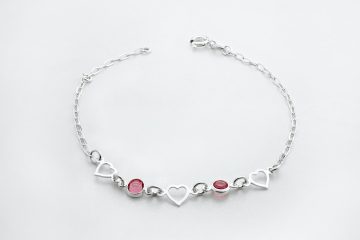Do you have a passion for crafting and a love for unique accessories? If so, jewelry making might be the perfect hobby for you. With just a few essential tools, you can start creating your own stunning bracelets that reflect your personal style. Whether you’re a beginner or an experienced crafter, this article will guide you through the must-have tools for bracelet making and help you unleash your creativity.
1. Beading Board: Organize Your Design
To ensure a seamless creation process, a beading board is an essential tool for any jewelry maker. This handy board is equipped with grooves and compartments that allow you to organize your beads and plan out your bracelet design. By using a beading board, you can avoid the frustration of losing beads or forgetting the order of your design. It serves as a visual aid, helping you experiment with different patterns and layouts before committing to a final design.
2. Jewelry Pliers: Your Trusty Sidekicks
Jewelry pliers are the backbone of any jewelry making project. These versatile tools come in various types, each serving a specific purpose. Round-nose pliers are perfect for creating loops and curves, while chain-nose pliers allow for precise bending and twisting of wire. Additionally, flat-nose pliers are ideal for gripping and holding small components. Investing in a good set of jewelry pliers will make your bracelet making process much smoother and more enjoyable.
3. Wire Cutters: Snip with Precision
Wire cutters are an absolute necessity for any jewelry maker. These specialized cutters are designed to cleanly and precisely cut through different gauges of wire. When crafting bracelets, you will often need to trim excess wire or create custom lengths. Using regular scissors can result in jagged edges and uneven cuts, which can compromise the overall quality of your piece. With wire cutters, you can achieve clean, professional-looking cuts every time, ensuring your bracelets are picture-perfect.
4. Crimping Tool: Secure Your Bracelet
Crimping is a technique used to secure clasps and closures to your bracelet, ensuring it doesn’t unravel or fall apart. A crimping tool is specifically designed for this purpose. It allows you to create neat and secure crimps on your jewelry wire, providing a strong and reliable connection. Without a crimping tool, achieving the same level of security and aesthetics can be challenging. This tool is a must-have for anyone looking to create bracelets that withstand the test of time.
5. Beading Needles: Thread with Ease
When working with smaller beads, a beading needle is an invaluable tool. Beading needles are thin and flexible, allowing you to easily thread beads onto your string or wire. Unlike regular sewing needles, beading needles have a smaller eye, making them suitable for smaller beads and delicate work. With a beading needle, you can thread your beads more efficiently, saving time and frustration. Whether you’re using seed beads or tiny gemstones, a beading needle will become your best friend during the bracelet making process.
6. Bead Mat: Prevent Rolling Beads
Have you ever experienced the frustration of chasing rolling beads across your workspace? A bead mat can help solve that problem. This soft, textured mat provides a non-slip surface for your beads, preventing them from rolling away. It also helps keep your work area organized and protects your beads from accidental damage. Using a bead mat will not only make your bracelet making process more efficient but also ensure that you don’t lose any precious beads along the way.
7. Beading Thread: Choose the Right One
Selecting the right beading thread is crucial for creating durable and long-lasting bracelets. There are various types of beading threads available, such as nylon, silk, and polyester. Each has its own advantages and is suitable for different types of bracelets. Nylon threads are known for their strength and flexibility, making them ideal for bead weaving and stringing projects. Silk threads, on the other hand, add an elegant touch to delicate bracelets. Polyester threads are great for heavy or bulky beads. Consider the type of bracelet you want to create and choose the appropriate beading thread accordingly.
8. Beads: A World of Possibilities
Now that you have all the essential tools, it’s time to explore the vast world of beads. Beads come in various shapes, sizes, colors, and materials, offering endless possibilities for creativity. From glass and gemstone beads to wooden and metal ones, the choices are virtually limitless. Consider the style and theme of your bracelet, and select beads that complement your design. Mix and match different beads to create a truly unique piece of jewelry that reflects your personal taste.
9. Clasps and Closures: The Finishing Touch
Clasps and closures are the final components that secure your bracelet around your wrist. There are numerous types of clasps available, ranging from lobster clasps to toggle clasps, magnetic clasps, and more. Each type offers its own unique aesthetic and functionality. Consider the style and ease of use when choosing a clasp for your bracelet. Additionally, you can explore various decorative closures, such as bead caps or button closures, to add a touch of flair to your design.
10. Design Inspiration: Let Your Imagination Soar
Feeling overwhelmed or unsure about where to start? Look no further than design inspiration. The internet is teeming with websites, blogs, and social media platforms dedicated to jewelry making. Browse through these resources to discover new techniques, trending styles, and innovative designs. You can also join online communities or attend local jewelry making workshops to connect with fellow crafters and gain valuable insights. Drawing inspiration from others can kickstart your creativity and help you develop your own unique style.
11. Patience and Perseverance: The Key to Mastery
As with any craft, patience and perseverance are essential for mastering the art of bracelet making. Don’t be discouraged if your first attempts don’t turn out exactly as you envisioned. Jewelry making is a skill that improves with practice. Embrace the learning process, experiment with different techniques, and don’t be afraid to make mistakes. Each bracelet you create will teach you something new and bring you closer to becoming a skilled jewelry maker.
12. Practice Safety: Protect Your Eyes and Hands
While bracelet making is a fun and rewarding hobby, it’s important to prioritize safety. When working with small components, always protect your eyes by wearing safety goggles. This will prevent any accidental injuries from flying beads or wire. Additionally, invest in a pair of comfortable and durable gloves to protect your hands from sharp edges or potential allergic reactions to certain materials. By practicing proper safety measures, you can enjoy your jewelry making sessions without any worries.
13. Clean and Organize Your Workspace
Maintaining a clean and organized workspace is essential for an enjoyable bracelet making experience. Keep your tools, beads, and materials neatly arranged and easily accessible. Use storage containers or drawers to categorize and separate your beads based on size, color, or type. This organization will save you time and prevent frustration when searching for specific components. Regularly clean your workspace to remove any dust or debris that could potentially damage your materials. A tidy workspace not only enhances your creativity but also ensures the longevity of your tools and supplies.
14. Experiment with Different Techniques
Bracelet making offers a plethora of techniques to explore. From basic stringing to beadweaving, wirework, and knotting, there are endless possibilities to expand your skill set. Don’t limit yourself to a single technique – challenge yourself to try new methods and combinations. Experimenting with different techniques will broaden your horizons and allow you to create unique and eye-catching bracelets that stand out from the crowd.
15. Share Your Creations: Spread the Joy
After mastering the art of bracelet making, don’t keep your creations to yourself. Share the joy of handmade jewelry with friends, family, and even potential customers. Host a jewelry party or set up an online shop to showcase and sell your bracelets. You never know, your passion for bracelet making might inspire others to explore their creative side. Celebrate your accomplishments and spread the joy of crafting by sharing your unique creations with the world.
In conclusion, bracelet making is a rewarding and creative hobby that allows you to express your personal style through handmade accessories. By equipping yourself with the essential tools and following the tips mentioned above, you can embark on a journey of crafting beautiful bracelets that reflect your unique taste and personality. Remember to embrace the learning process, practice patience, and let your creativity soar. Happy bracelet making!
—
FAQs:
1. Can I use regular pliers instead of jewelry pliers for bracelet making?
While regular pliers can be used in some instances, jewelry pliers are specifically designed for jewelry making and offer greater precision. Regular pliers may not have the necessary features, such as rounded or flat noses, required for certain techniques. Investing in a good set of jewelry pliers is highly recommended for a seamless bracelet making experience.
2. How do I choose the right size of beading needle for my project?
When choosing a beading needle, consider the size of the beads you will be working with. If you are using smaller beads, opt for a thinner needle with a smaller eye. For larger beads, a thicker needle will be more suitable. It’s always a good idea to have a variety of needle sizes on hand to accommodate different bead sizes and styles.
3. Can I use regular sewing thread for bead weaving?
Regular sewing thread is not recommended for bead weaving projects. Sewing thread is not as strong or durable as beading thread, which can result in breakage or damage to your bracelet. Beading threads, such as nylon or silk, are specifically designed to withstand the tension and wear associated with bead weaving techniques.
4. How do I care for my handmade bracelets?
To ensure the longevity of your handmade bracelets, it’s important to handle them with care. Avoid exposing them to harsh chemicals, excessive moisture, or direct sunlight. When not in use, store them in a clean and dry place, preferably in individual jewelry pouches or compartments to prevent tangling or scratching. Regularly clean your bracelets using a soft cloth to remove any dirt or oils that may accumulate over time.
5. Can I sell the bracelets I make?
Absolutely! Once you have honed your bracelet making skills and created a collection of stunning pieces, you can sell them through various channels. Online platforms like Etsy and social media marketplaces allow you to showcase and sell your handmade jewelry to a wide audience. Additionally, local craft fairs, artisan markets, or hosting your own jewelry parties are great opportunities to connect with potential customers and share your passion for handmade bracelets.




